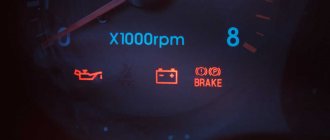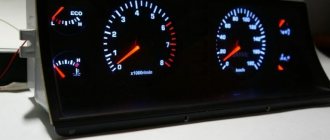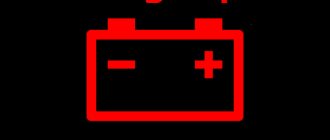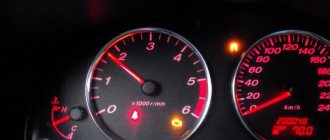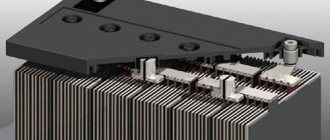Overcharging of a car battery occurs when a voltage higher than the maximum permissible - 14.6–14.8 V is applied to its terminals. This problem is most typical for older models (UAZ, “classic” VAZ) and cars with high mileage due to design features and unreliable elements electrical equipment.
Overcharging is possible if the generator fails or if the charger is used incorrectly. This article will help you understand why the battery is overcharging, why it is dangerous, whether a car battery can be overcharged in a working car, and how to find and eliminate the cause of overcharging.
How to determine if a battery is overcharged
You can reliably determine whether a battery is overcharged by measuring the voltage at the battery terminals using a multimeter. The verification procedure is as follows:
- Start the engine and warm it up to operating temperature, waiting until the speed drops to idle.
- Turn the multimeter into the mode for measuring direct (DC) voltage in the range of 20 V.
- Connect the red probe to the “+” terminal, and the black one to the “–” terminal of the battery.
On cars with calcium batteries, the voltage can reach 15 V or higher.
The average voltage in the on-board network in the absence of switched-on consumers (headlights, heating, air conditioning, etc.) is in the range of 13.8–14.8 V. A short-term excess of up to 15 V is acceptable in the first minutes after starting if the battery is significantly discharged! A voltage above 15 V at the terminals indicates that the car battery is overcharged.
You should not unconditionally trust the voltmeters built into the cigarette lighter adapter or head unit. They show voltage taking into account losses and are not highly accurate.
The following signs also indirectly indicate that the battery in the car is overcharging:
Oxidized terminals covered with a green coating are an indirect sign of frequent recharging.
- the lamps in the headlights and interior lighting glow brighter;
- fuses often blow out (at low voltage they can also burn due to increased currents);
- the on-board computer signals about excess voltage in the network;
- the battery is swollen or traces of electrolyte are visible on the case;
- The battery terminals oxidize and become covered with a green coating.
When stationary charging a battery, overcharge is determined by indications, sound or visually. The charging voltage should not exceed 15–16 V (depending on the type of battery), and the charging current should not exceed 20–30% of the battery capacity in ampere-hours. Gurgling and hissing, active formation of bubbles on the surface of the electrolyte immediately after installation for charging indicate its boiling and non-optimal charging mode.
An overcharged battery holds its charge worse, overheats, its casing can swell and even burst, and the leaking electrolyte corrodes the paintwork and pipes. Increased voltage in the network leads to failure of electrical equipment. To prevent this, the problem must be urgently resolved by finding out why the battery is being overcharged. Read below about how to do this.
Battery charging circuit
For a general understanding of the causes of overload, first consider the battery charging circuit. And although it is structurally different on different machines, the general design principle is the same.
This chain includes:
The charging system works on the example of the VAZ 2106 and other VAZ classic series cars as follows:
Below is a detailed diagram.
Why is the battery being recharged?
Overcharging the battery from the charger is a consequence of incorrect selection of charging time, voltage and current in manual mode or a malfunction of the charging unit itself. A short-term recharge from a charger is less dangerous than from a generator, since it usually does not have time to lead to irreversible consequences.
The reasons for overcharging the car battery on board are 90% due to a faulty generator. Therefore, it is this that needs to be inspected and checked first. Less commonly, the cause of battery overcharging lies in wiring faults. Specific causes of increased voltage and their consequences are listed in the table.
Table of reasons for overcharging a car battery:
| Causes | What causes overcharging? |
| Generator relay problems | The relay is not working correctly, the voltage in the on-board network is too high or voltage surges are observed. |
| Faulty generator | The generator, due to a short circuit in the windings, a breakdown in the diode bridge or for other reasons, cannot maintain the operating voltage. |
| Regulator relay failure | The voltage regulator relay (“tablet”, “chocolate bar”) does not function, which is why the output voltage significantly exceeds the permissible value. |
| Weak contact of the relay-regulator terminal | Due to the lack of contact, the relay receives an undervoltage, as a result of which a compensating effect is not generated. |
| Consequences of generator tuning | To increase the voltage on older models (for example, VAZ 2108-099), craftsmen install a diode between the terminal and the relay regulator, which lowers the voltage by 0.5–1 V in order to deceive the regulator. If the diode was initially selected incorrectly or the drop increased due to its degradation, the voltage in the network increases beyond the permissible limit. |
| Weak contact in wiring | When the contacts on the connecting blocks oxidize and move away, the voltage on them drops, the regulator regards this as a drawdown and increases the output voltage. |
In some vehicles, battery overcharging from the alternator is a common problem caused by design flaws. The table below will help you find out which models are overcharging the battery and what is the reason for it.
Generators of modern cars, designed to use calcium batteries (Ca/Ca), produce higher voltages than on older models. Therefore, the voltage of the on-board network is 14.7–15 V (and for a short time in winter - even more) is not a sign of overcharging!
A table with the causes of “congenital defects” in some cars, which lead to overcharging of the battery:
| car model | Reason for recharging the battery from the generator |
| UAZ | Overcharging often occurs due to poor contact of the regulator relay. It often occurs on “loaves”, but it also happens on Patriots. At the same time, the original voltmeter is not yet an indicator of overcharge, since it can go off scale for no reason. You need to check the recharge only with a known accurate device! |
| VAZ 2103/06/7 (classic) | Poor contact in the contact group of the lock (terminals 30/1 and 15), on the contacts of the relay-regulator, and also due to poor ground contact between the regulator and the car body. Therefore, before replacing the “chocolate”, you need to clean all these contacts. |
| Hyundai and Kia | On Hyundai Accent, Elantra and other models, as well as on some KIAs, the voltage regulator unit on the generator (catalog number 37370-22650) often fails. |
| Gazelle, Sable, Volga | Poor contact in the ignition switch and/or fuse box connector. |
| Lada Priora | Voltage drop at generator contact L or 61. If it is lower by more than 0.5 V than at the battery, you need to check the wiring and look for the place of the drawdown. |
| Ford Focus (1,2,3) | Voltage drop at the generator regulator connector (red wire). Often the regulator itself fails. |
| Mitsubishi Lancer (9, 10) | Oxidation or breakage in the generator chip of contact S (usually orange, sometimes blue), due to which the RR produces increased voltage. |
| Chevrolet Cruze | A mains voltage slightly higher than 15 V is normal! The ECU analyzes the condition of the battery and, using PWM, regulates the voltage supplied to it in the range of 11–16 V. |
| Daewoo Lanos and Nexia | On Daewoo Lanos (with GM engines), Nexia and other GM cars with “related” engines, the reason for overcharging almost always lies in a malfunction of the regulator. The problem of replacing it is complicated by the difficulty of dismantling the generator for repairs. |
Which cars are affected by the problem?
Naturally, the probability of the battery receiving an excess charge on new foreign cars is significantly lower than on products with a significant mileage from the domestic automobile industry. However, there are a number of models where overcharging is considered a common problem.
We are talking about classic VAZ cars. Among the “classics”, this malfunction most often occurs on the “six” (VAZ 2106).
Trucks and some UAZ models are equipped with on-board voltage sensors and sometimes these sensors begin to signal an increase in the charging current between the generator and the battery (18V or more). This is not normal and may lead to rapid overcharging. However, often the problem is in the sensors themselves, which show incorrect information.
What causes battery overcharging?
When a problem is identified, it is important to urgently eliminate overcharging of the car battery, the consequences of which may not be limited to battery failure. Due to the increased voltage, other components may also fail. What does overcharging of the battery lead to and for what reasons - see the table below:
What are the dangers of overcharging the battery: main malfunctions
| Consequences of overcharging | Why is this happening | How can this end? |
| Electrolyte boiling away | If current continues to flow to a 100% charged battery, this causes active boiling of the electrolyte and the formation of oxygen and hydrogen in the banks. | A decrease in the electrolyte level leads to overheating and destruction of the plates. A small explosion and fire are possible due to the ignition of hydrogen (due to a spark discharge between the exposed plates). |
| Shedding of plates | Under the influence of current, the plates, which were exposed after the liquid boiled away, overheat, their coating cracks and crumbles. | The battery cannot be restored; you will have to buy a new battery. |
| Electrolyte leakage | As the electrolyte boils away, it is released through the ventilation holes and enters the battery housing. | The acid contained in the electrolyte corrodes the paintwork in the engine compartment, some types of wire insulation, pipes and other parts that are not resistant to aggressive environments. |
| Battery swelling | When the electrolyte boils, the pressure rises and the batteries (especially maintenance-free ones) swell. Lead plates crumble or short out due to deformation. | If excessive pressure is applied, the battery housing may burst, damaging and spattering acid into parts under the hood. |
| Terminal oxidation | As the acid electrolyte evaporates from the battery, it condenses on adjacent parts, causing the battery terminals and other components to become covered with a layer of oxides. | Deteriorated contact leads to disruption of the electrical network on board; acid can corrode the insulation and pipes. |
| Electronics failure | Overvoltage causes damage to power-sensitive electronic components and sensors. | Due to excess voltage, lamps and fuses burn. In modern models, failure of the ECU, air conditioning unit and other on-board electronics modules is possible. There is an increased risk of fire due to overheating and destruction of insulation, especially when using non-standard low-quality accessories and spare parts. |
| Generator burnout | Failure of the relay regulator and short circuit of the windings cause overheating of the generator. | If overheating of the generator leads to burnout of its windings, you will have to rewind the stator/rotor (which is time-consuming and expensive) or replace the generator assembly. |
Regardless of the type of battery, it is important to prevent it from overcharging. For all types of batteries, overcharging the battery is equally dangerous, but the consequences may be different:
A battery explosion is a consequence of overcharging.
- Antimony (Sb-Sb) . Classic serviceable batteries, in which the plates are doped with antimony, survive a short overcharge relatively easily. With timely maintenance, everything will be limited to adding distilled water. But it is these batteries that are more sensitive to high voltage, since recharging is possible already at a voltage of more than 14.5 volts.
- Hybrid (Ca-Sb, Ca+) . Maintenance-free or low-maintenance batteries, the positive electrodes of which are doped with antimony, and the negative electrodes are doped with calcium. They are less afraid of overcharging, withstand voltages better (up to 15 volts), and slowly lose water from the electrolyte when boiling. But, if you allow a strong overcharge, then such batteries swell, a short circuit is possible, and sometimes the case ruptures.
- Calcium (Ca-Ca) . Maintenance-free or low-maintenance batteries of the most modern subtype. They are characterized by minimal water loss during boiling, are resistant to high voltage (at the last stage they are charged with a voltage of up to 16–16.5 volts), therefore they are minimally susceptible to overcharging. If you allow it, the battery may also burst, splashing everything with electrolyte. Strong overcharge and deep discharge are equally destructive, as they cause irreversible degradation of the plates and their shedding.
- With absorbed electrolyte (AGM) . AGM batteries differ from classic ones in that the space between the electrodes is filled with a special porous material that absorbs electrolyte. This design prevents natural degradation, allowing it to withstand many charge-discharge cycles, but it is very susceptible to overcharging. The maximum charging voltage is up to 14.7–15.2 V (indicated on the battery), if more is applied, there is a high risk of electrodes shedding. And since the battery is maintenance-free and sealed, it can explode.
- Gel (GEL) . Batteries in which the liquid acid electrolyte is thickened with silicon compounds. These batteries are practically not used as starter batteries, but can be installed to power powerful consumers on board (music, etc.). They tolerate discharge better (withstand hundreds of cycles), but are afraid of overcharging. The maximum voltage for GEL batteries is up to 14.5–15 V (sometimes up to 13.8–14.1). Such a battery is sealed, so it is easily deformed and cracked when overcharged, but in this case there is no danger of electrolyte leakage.
Diagnostics of the relay regulator
Checking the relay regulator when charging the battery is not a complicated procedure and you can do it yourself using a multimeter.
Control is reduced to measuring the voltage at the terminals of the battery in various operating modes of the control panel. That is, we simply connect the multimeter probes to the terminals and measure the voltage first at idle, then at medium speed and then at high speed.
At idle, the normal voltage is 13.2-14.0V, at medium speeds - 13.6-14.2V, at high speeds - up to 14.5V.
If the values exceed the specified values, check and clean the charging system circuit contacts and repeat the procedure again.
If cleaning does not help, we check the relay separately (remove it from the car), but for this you will need a power supply with adjustable voltage (you can use a charger), as well as a regular 12 V lamp.
The essence of the control is this: we connect the “minus” wire from the charger to the case, and connect the “plus” wire to the output of the regulator. The lamp is connected to graphite brushes (polarity is not important).
When checking, first set the voltage on the source to 12.7 V, at which the lamp should light up. Gradually increase the value to 14.5 V. When the specified value is reached, the working regulator should operate and the lamp will go out.
If it continues to light when it exceeds 14.5V, the device is faulty and needs to be replaced.
What to do when recharging?
When recharging a battery, you should first find the root cause, and then diagnose the battery. What you need to do when recharging a battery for specific reasons is described below.
Recharging with a stationary charger
Overcharging the battery from the charger is possible when using a faulty power supply or incorrectly selected charging parameters in manual mode.
- Maintenance-free batteries are charged with a constant current of 10% of their capacity. The voltage will be adjusted automatically, and when it reaches 14.4 V, the current must be reduced to 5%. Charging should be interrupted no more than 10–20 minutes after the electrolyte begins to boil.
- Serviced . Use constant charging voltage recommended for your battery (slightly higher for calcium batteries than for hybrid or AGM batteries). When the capacity reaches about 100%, the current will stop flowing and charging will stop on its own. The process can take up to a day.
Before charging a serviced battery, check the density of the electrolyte with a hydrometer. If it does not correspond to normal for a given state of charge, then even when charging with standard voltage and current, overcharging is possible.
Overcharging of a car battery by a charger usually occurs due to a malfunction of certain components. In transformer chargers, the cause of an increase in voltage is often an interturn short circuit of the winding, a breakage of the switch and a malfunction of the diode bridge. In automatic pulse memory devices, the radio components of the control controller, for example, transistors or an optocoupler regulator, often fail.
Protection of a car battery from overcharging is guaranteed when using a charger assembled according to the following scheme:
Protecting the battery from overcharging: do-it-yourself circuit
12 volt battery overcharge protection: charger circuit
Recharging a car battery from a generator
If overcharging of the battery is detected while traveling, you need to protect the battery from boiling over or exploding by reducing the supply voltage or turning off its supply in one of three ways:
- Loosening the tension of the generator belt . The belt will slip, whistle and most likely become unusable and require replacement in the near future, but the power of the generator will drop.
- Turn off the generator . By removing the wires from the generator and insulating the hanging terminals, you can get home on the battery, using minimal electrical appliances on board. A charged battery will last for about 1–2 hours of driving without headlights on, with headlights on – half that time.
- Remove the belt from the generator . This advice applies to models in which the alternator is driven by a separate belt. The effect is identical to the previous option, but the method may be simpler if you unscrew the two tension screws to remove the belt. This is more convenient than removing terminals and insulating wires.
If the generator voltage does not exceed 15 volts, and you are traveling close, there is no need to turn off the generator. Just drive at low speed to the repair site, turning on as many consumers as possible: low beam, heater fan, glass heating, etc. If additional consumers allow you to reduce the voltage, leave them on.
Sometimes turning on additional consumers helps to find the cause of overcharging. If the voltage drops as the load increases, the problem is probably in the regulator, which simply increases the voltage. If, on the contrary, it grows, you need to look at the wiring for poor contact (twists, oxides of connectors, terminals, etc.).
The battery is overcharged from the generator when the regulating elements (diode bridge, regulator relay) do not operate correctly. The general check procedure is as follows:
- The voltage at the battery terminals at idle speed should be 13.5–14.3 V (depending on the car model), and when it increases to 2000 or more, it increases to 14.5–15 V. If it rises noticeably more, recharging occurs.
- The difference between the voltage at the battery terminals and at the output of the relay regulator should not exceed 0.5 V in favor of the battery. A big difference is a sign of poor contact.
- We check the relay regulator using a 12-volt lamp. You need an adjustable voltage source with a range of 12–15 V (for example, a charger for a battery). Its “+” and “-” must be connected to the PP input and ground, and the lamp to the brushes or PP output. When the voltage increases above 15 V, the lamp that lights up when power is applied should go out. If the lamp continues to light, the regulator is faulty and must be replaced.
Relay-regulator test circuit
Checking the regulator relay: video
If the relay-regulator works, you need to check the wiring. When the voltage drops in one of the circuits, the generator gives full load and the battery is recharged.
To prevent overcharging of the battery, monitor the condition of the wiring and periodically check the voltage at the terminals. Do not keep wires twisted, solder connections and use heat shrink tubing instead of electrical tape to protect connections from moisture!
In some cars, in which charging goes from the B+ terminal of the generator directly to the battery, you can, to be on the safe side, organize protection of the battery from overcharging through a voltage control relay like 362.3787-04 with a regulation range of 10–16 V. Such protection from overcharging a 12 volt battery will stop the power supply on it when the voltage rises above what is permissible for this type of battery.
Installation of additional protection is justified only on older models, which are especially susceptible to battery overcharging due to design flaws. In other cases, the regulator independently copes with charging control.
A relay is connected to the gap in wire P (marked with red stripes).
Generator connection diagram:
- Accumulator battery.
- Generator.
- Mounting block.
- Battery charge indicator lamp.
- Ignition switch.
Before installing the relay on the charging wire from the generator to the battery, study the wiring diagram of your car model. Make sure that if the wire is broken using a relay, the current will not bypass the battery!
Causes of overcharging and increased voltage in the vehicle’s on-board network
A faulty relay regulator is the most common cause of battery overcharging.
Due to a breakdown, this unit ceases to perform its functions and “passes” all the voltage generated by the generator into the on-board circuit and can reach 16 and even 25 V. Of course, not a single electrical device in the car works designed for this voltage, then the elements of the on-board the networks begin to burn.
Damage to the regulator may be partial or complete. In the first case, this element still performs its functions, but “passes” a voltage slightly higher than necessary (for example, 16 volts).
In this case, battery overload can only be determined by readings from measuring instruments or the on-board computer. Electric consumers practically do not “suffer” from this voltage, but this voltage also negatively affects the condition of the battery: with a constant process, the battery “boils” and fails.
If the relay-regulator is completely malfunctioning, high frequencies (above 16 V) begin to disconnect consumers: first the light bulbs and fuses burn out, then other devices. Significant overvoltage can cause electrical wiring to catch fire.
Despite the fact that partial failure of the relay does not pose a significant threat to the vehicle’s on-board network (with the exception of the battery), it should not be ignored, since it can at any time turn into a complete failure of the element.
Since the relay-regulator is the only element that prevents the battery from being overloaded, many motorists, upon detecting an increase in voltage in the on-board network, immediately replace this unit.
But installing a new regulator does not always help; often the problem remains. Of course, suspicion in this case falls on the generator. This unit can really provide recharging if the diode bridge breaks down or the winding breaks, or the armature to the housing fails.
READ ON THE TOPIC: Car generator voltage, speed at idle and under load.
But if replacing the regulator relay does not help, then there is no need to immediately change or send the generator for repair.
IMPORTANT: Often the cause of battery overcharging is poor contact in the wiring of the battery charging system circuit (described above).
The reason is very simple: at the point where the contacts are oxidized, resistance arises, which the relay-regulator “perceives” as a load in the on-board network. For example, this could happen in the fuse box.
To compensate for this and prevent a drop in voltage, the regulator begins to “pass” large values, as a result, an increased voltage is supplied to the battery.
Therefore, when looking for the cause of battery overcharging, you should first check:
And only after that we remove and diagnose the generator.
What to do if your car battery explodes
Most frequently asked questions
Will the battery be recharged if a higher power generator is installed?
No, because regardless of the power of the generator, the voltage at its output is limited by the relay regulator to the maximum permissible for the battery.
Does the diameter of the power wires affect recharge?
The increased diameter of the power wires in itself cannot cause the battery to overcharge. However, replacing damaged or poorly connected wiring may increase the charging voltage if the alternator is faulty.
How to properly connect the second (gel) battery so that there is no overcharging?
To prevent overcharging of the gel battery, it must be connected through an isolation device. To prevent overvoltage, it is advisable to use a limiter terminal or another voltage controller (for example, voltage control relay 362.3787-04).
The generator recharges the battery, is it possible to drive home with the battery removed?
If the relay regulator is broken, you cannot disconnect the battery at all. Reducing the load will raise the already high voltage from the generator, which can cause lamps and on-board electronics to fail. Therefore, when recharging the car instead of the battery, turn off the generator.
Do I need to change the electrolyte after recharging the battery for a long time?
The electrolyte in the battery is changed only after the battery has been refurbished. Replacing the electrolyte that has become cloudy due to crumbling plates by itself does not solve the problem. If the electrolyte is clean, but its level is low, you need to add distilled water.
How long can a battery be charged to increase the density of the electrolyte (evaporate water)?
Time limits are individual and depend on the initial density. The main thing is not to exceed the charge current of 1–2 A and wait until the electrolyte density reaches 1.25–1.28 g/cm³.
Features of the circuit or why the generator voltage may jump
Above is a general connection diagram, without details, but it is enough to understand how it all works. Now about the features of battery charging.
The generator cannot independently regulate the parameters of the generated electricity, so the output voltage from it varies (jumps) and depends in a significant range on the crankshaft speed and the load in the on-board circuit.
That is, the battery overload is essentially constantly present while the generator is producing energy.
In order for the battery to accept a charge, it is necessary to apply a voltage slightly higher than the nominal value of the battery. On different cars, the input voltage to the battery is different, but in general this figure ranges from 13.9 to 14.5 V.
It is at this voltage that the battery can “take” a charge. If the voltage is lower, the battery will be undercharged, and if the voltage is higher, it will be overcharged. Both situations have a negative impact on the battery.
The generator produces a voltage with a high value, and in order to maintain it in the circuit within the required limits, a relay regulator is included in the circuit.
On some models, this element is included in the design of the generator and is combined with a brush group (the most common design) or represents a separate group (found, for example, on VAZs of the classic family).
After all, the relay-regulator is the only element responsible for ensuring that the voltage in the on-board network corresponds to the norm and that no overloads occur, and for taking into account the load created in the on-board network when switching electrical consumers to.
Human factor
The sad statistics most often include battery explosions when charging from an external device. Possible reasons:
- battery charging current is too high;
- Long-lasting charge with high current with screwed caps. The plugs are designed to control the level and density of the electrolyte and to allow gas to escape during routine battery maintenance. When charging, to prevent the risk of explosion, manufacturers recommend unscrewing the plugs;
- battery recharge. If the charger does not have an automatic charging function, you need to monitor the current consumption level and the total charging time. The greatest risk of explosion is when using old chargers in which it is impossible to adequately adjust the voltage level and current strength.
Getting to the repair site
Finally, what to do if an overcharge is detected along the way and you need to get to the repair site.
If the voltage does not exceed 15 V, it is safe to continue driving, but try not to give the engine high speeds and reduce the number of switched on electrical consumers as much as possible (keep only the necessary ones).
If the overload is severe (more than 16 volts), you can first loosen the tension on the generator drive belt, which will reduce its performance (although the belt will wear out quickly).
If loosening the belt does not help and the voltage continues to jump to high values, you can turn off the generator (disconnect the wires from it). In this case, the on-board network will be powered only by the battery.
If the battery is well charged with a minimum number of charged consumers, you can drive 70-90 km, but in the future the battery will have to be well charged with a charger.
Source
Physico-chemical prerequisites for explosion
When charging a lead-acid battery, water is decomposed at the molecular level into hydrogen and oxygen. Some of the gases settle on the surface of the positive plates. The second part is an explosive mixture that accumulates under the battery housing cover. The mixture is extremely explosive, and therefore even the slightest spark is enough to set it on fire. Such sparks can occur between plates with positive and negative potential, as well as in places where they are connected in series.
For a car battery to explode, several negative factors must come together in a chain:
- decrease in electrolyte level in banks;
- long battery recharge;
- a clogged bypass valve, which in maintenance-free batteries is designed for emergency release of accumulated explosive gas;
- untimely battery maintenance;
- prolonged high load on the battery, followed by high current charging. If you unsuccessfully tried to start a cold engine, and then the battery exploded under the hood when lighting a cigarette, most likely, the actions developed exactly according to this scenario.
Self-test of the generator
The easiest way is to check the fuse. If it is in good condition, the generator and its location are inspected. The free rotation of the rotor, the integrity of the belt, wires, and housing are checked. If nothing arouses suspicion, the brushes and slip rings are checked. During operation, the brushes inevitably wear out, they can become jammed, skewed, and the grooves of the slip rings become clogged with graphite dust. A clear sign of this is excessive sparking.
There are frequent cases of complete wear or failure of both bearings and stator failure.
The most common mechanical problem with a generator is bearing wear. A sign of this malfunction is a howling or whistling sound when the unit is operating. Of course, the bearings must be replaced immediately, after first inspecting the seats. Loose drive belt tension can also cause poor generator performance. One of the signs may be a high-pitched whistle from under the hood when the car accelerates or accelerates.
To check the rotor field winding for short-circuited turns or breaks, you need to connect a multimeter, switched to resistance measurement mode, to both contact rings of the generator. Normal resistance is from 1.8 to 5 ohms. The readings below indicate the presence of a short circuit in the turns; above – direct winding break.
To check the stator windings for ground fault, they need to be disconnected from the rectifier unit. If the resistance readings given by the multimeter are infinitely large, there is no doubt that there is no contact between the stator windings and the housing (“ground”).
To check the diodes in the rectifier block, use a multimeter (after completely disconnecting it from the stator windings). The test mode is “diode test”. The positive probe is connected to the plus or minus of the rectifier, and the negative probe is connected to the phase terminal. After this, the probes are swapped. If the values of the multimeter readings differ greatly from the previous ones, the diode is working; if they do not differ, it is faulty. Another sign indicating the imminent “death” of the generator diode bridge is oxidation of the contacts, and the reason for this is overheating of the radiator.
Alternating current
The generator includes a rectifier unit (diode bridge), which converts alternating current to direct current. It is equipped with diodes that allow current to flow in only one direction. Burnt-out diodes not only undercharge the battery, but also discharge it (how to replace a diode bridge?). In addition to discharging, a faulty diode bridge can supply alternating current to the battery, causing the latter to boil.
To summarize, we recall that the main reasons are: a non-working device that allows you to change the value of the electrical voltage, a diode bridge with burnt elements and a shortened bank.
Common battery problems:
- short circuit of battery electrodes/plates;
- mechanical or chemical damage to the battery plates;
- violation of the tightness of battery cans - cracks in the battery case as a result of impacts or improper installation;
- chemical oxidation of the battery terminals. The main causes of these malfunctions are:
- gross violations of operating rules;
- expiration of the product's service life;
- various manufacturing defects.
It is very useful for a motorist to know the main causes of generator malfunctions , how to eliminate them, as well as preventive measures to prevent breakdowns.
All generators are divided into alternating and direct current generators. Modern passenger vehicles are equipped with alternating current generators with a built-in diode bridge (rectifier). The latter is necessary to convert current into direct current, on which the vehicle's electrical consumers operate. The rectifier, as a rule, is located in the cover or housing of the generator and is integral with the latter.
All electrical appliances of the car are designed for a strictly defined operating voltage range. As a rule, operating voltages are in the range of 13.8–14.7 V. Due to the fact that the generator is “tied” with a belt to the engine crankshaft, it will work differently . It is for smoothing and regulating the output current that the relay-voltage regulator is designed, playing the role of a stabilizer and preventing both surges and dips in the operating voltage. Modern generators are equipped with built-in integrated voltage regulators, colloquially referred to as “chocolate” or “tablet”.
It is already clear that any generator is a rather complex unit, extremely important for any car.
Consequences
As I already wrote above, they discharged deeply several times and that’s it! The battery can be thrown away! The positive plates will be completely covered with salts, the density of the electrolyte will drop and will not increase. Even if you replace the electrolyte with a new one of the required density, it will not wash away the formed salts.
As many battery manufacturers assure, the maximum threshold value is 15 - 20 cycles. But I know from experience that after 10 cycles, such a battery cannot cope with its duties in winter; it will still work in summer.
The moral of the story is - do not allow such deep discharge parameters. This really kills your battery, each time you take away about 3% of the capacity.
Reasons for this phenomenon
Guys, I’ll say a few words about “special” recharging from a charger - many people do this on purpose! REMEMBER! Thus, they increase the density of the electrolyte to the required level - in our band it is approximately 1.27 g/cm3, if the density is lower (already with a charged battery), then the battery may freeze at subzero values. We need to raise it! And how to do it? It’s very simple - you need to evaporate a small amount of water from the electrolyte, thus the acid concentration will increase and the density will increase.
Therefore, many car enthusiasts “boil” the battery at a low current, from the charger, but only up to a certain density value. After this, charging is turned off. Otherwise, you will simply ruin the battery. It is especially important to prevent the plates from being exposed.
Now “non-special” overcharging, as they say under the hood of the car, its main reasons:
- The generator charge regulator relay has failed . This relay “sees” charging, and when it reaches 12.7 Volts, it turns off the power supply from the generator. If this relay fails, then the generator will constantly charge the battery, and its currents are considerable, it will boil very quickly! This is the most common reason. Fortunately, this relay costs a penny. A short video, let's watch.
